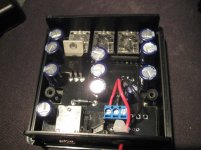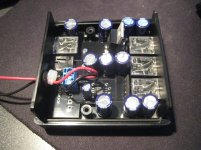I have two stereo outputs from two preamps. I wish to combine them into one, to feed into a power amp. I do not need a volume control or crossfade, or anything, just to join them. What is the simplest way to do this, minimising all distortion? or is there no simple solution...? Sorry if it's a dum question
Do you mean so you can listen to one or the other ?... surely not both at the same time  And I guess you don't want a switch either to select between the two.
And I guess you don't want a switch either to select between the two.
I would imagine feeding both into a virtual earth mixer would be best for eliminating interactions etc
fig 2 here,
Universal Preamp/ Mixer
Use a second inverting stage to preserve absolute phase if that is important to you.
I would imagine feeding both into a virtual earth mixer would be best for eliminating interactions etc
fig 2 here,
Universal Preamp/ Mixer
Use a second inverting stage to preserve absolute phase if that is important to you.
If you have enough gain and headroom (usually the case; most preamps will deliver 20dBs more than it takes to drive amps into clipping) you could put a resistor in series with each output of each preamp (I've a penchant for 10 kilohms, but as long as they're all the same, anything from about one k to fifty k will work) and allow the low impedance on the output of the preamps themselves to absorb crosstalk. Not that you really care about crosstalk. You aren't mixing the output of a tube preamp with an op-amp one, I hope?
Zero added distortion, a tiny bit of extra noise due to level lost, but you're going to get that with any mix setup, if the resistors are mounted close to the power amp almost no extra hum and buzz pickup (well, all the standard grounding problems when you add an extra source – and you wonder why we do everything balanced?), the only negative if you turn the power off one preamp it will cause a slight but audible increase in gain on the other.
Zero added distortion, a tiny bit of extra noise due to level lost, but you're going to get that with any mix setup, if the resistors are mounted close to the power amp almost no extra hum and buzz pickup (well, all the standard grounding problems when you add an extra source – and you wonder why we do everything balanced?), the only negative if you turn the power off one preamp it will cause a slight but audible increase in gain on the other.
Mooly - yes, I do mean listen to two at once 
It's something I'd switch in to the system when I needed it, I accept that mixing preamps is never going to sound beautiful really.
chrispenycate: sounds grand - as I say, it's a workaround really, and not something I'd be using on a permanent basis. Op amp on both.
Thanks guys
It's something I'd switch in to the system when I needed it, I accept that mixing preamps is never going to sound beautiful really.
chrispenycate: sounds grand - as I say, it's a workaround really, and not something I'd be using on a permanent basis. Op amp on both.
Thanks guys
Hi Guys, I just found this post and I'm looking to do the same thing for earphone outputs.
I have two devices with earphone outputs that I want mixed to the earphones. Can I get away with using resistors like above?
My main concern is that the devices are protected. I've read that just using a splitter to connect two source signals to one set of earphones could damage one of the source units.
In case it matters, this is for a garmin GPS with stereo earphone output and a radar detector with stereo earphone output. I need to be able to hear the radar alerts over my music and directions on the GPS and would like to keep this as simple as possible. If you can call having GPS and radar on a bike simple
I have two devices with earphone outputs that I want mixed to the earphones. Can I get away with using resistors like above?
My main concern is that the devices are protected. I've read that just using a splitter to connect two source signals to one set of earphones could damage one of the source units.
In case it matters, this is for a garmin GPS with stereo earphone output and a radar detector with stereo earphone output. I need to be able to hear the radar alerts over my music and directions on the GPS and would like to keep this as simple as possible. If you can call having GPS and radar on a bike simple
Rane's handbook has an interesting chapter on "Y" connectors explaining the correct way of combining two signals. They show a few simple passive circuits which work well from my experience.
Why Not Wye?
Why Not Wye?
Thanks for the link Gray. It looks very similar to what others have said to do but with the addition of a third resistor.
So this method of summing will work okay for earphones as well as line level?
Are line level and earphone outputs close to the same?
Will I get any appreciable volume loss from the resistors?
So this method of summing will work okay for earphones as well as line level?
Are line level and earphone outputs close to the same?
Will I get any appreciable volume loss from the resistors?
Line level is higher impedance than earphones, and is really just supplying a voltage; the current is just there to generate the voltage across the load impedance. Earphones need power, although much less than a loudspeaker. The resistors will cause a volume loss. This is unavoidable with a simple resistive signal mixer, as each output is driving both the earphones and the other output via an attenuator. You can do better by using a transformer, essentially doing an audio version of an RF signal combiner, but this is probably not worth it.
I asked Garmin and they said the earphone output was rated for 16 to 32 ohms.
So would this simple passive mixer with the resistors attenuate by a large percentage?
Also, are the source units completely safe with this passive mixer?
How about an automatic switch like this unit Pac-Audio.com Product Details | iPod Integration for your car and More by Pac-Audio - Connecting you to the future
It switches to the axillary audio source whenever it senses a signal.
Could I build something like this with a voltage sensative relay?
So would this simple passive mixer with the resistors attenuate by a large percentage?
Also, are the source units completely safe with this passive mixer?
How about an automatic switch like this unit Pac-Audio.com Product Details | iPod Integration for your car and More by Pac-Audio - Connecting you to the future
It switches to the axillary audio source whenever it senses a signal.
Could I build something like this with a voltage sensative relay?
After some more searching I found this little unit Welcome to Electric-Avenues.com - The AmpliRider
It does exactly what I want for 65.00 US.
I could probably build something similar . It's likely just a mixer using resistors with an amp.
I wonder what it would cost to build one from scratch?
It does exactly what I want for 65.00 US.
I could probably build something similar . It's likely just a mixer using resistors with an amp.
I wonder what it would cost to build one from scratch?
Could someone give me their opinion about this kit?
MINI HA1 Headphone amplifier kit DIY - eBay (item 120696648115 end time May-10-11 09:24:12 PDT)
I figure I could build it and add the resistors and additional inputs. And it will run off of the 14 volts from my bike.
Does it look like it will be decent sound quality? At least as good as a Gamin GPS playing MP3s through earbuds on a bike. I'm an audiophile, just don't want any horrible buzzing or noise.
Thanks, Will
MINI HA1 Headphone amplifier kit DIY - eBay (item 120696648115 end time May-10-11 09:24:12 PDT)
I figure I could build it and add the resistors and additional inputs. And it will run off of the 14 volts from my bike.
Does it look like it will be decent sound quality? At least as good as a Gamin GPS playing MP3s through earbuds on a bike. I'm an audiophile, just don't want any horrible buzzing or noise.
Thanks, Will
No good I suspect for you as it runs off a "split supply" meaning pos and neg rails. You want a simple AC coupled amp using something like the TDA2822 which is ideal for a headphone amp.
http://www.datasheetcatalog.org/datasheet/SGSThomsonMicroelectronics/mXsrtww.pdf
Any hums and buzzes on any amp would be down to noisy supplies and poor wiring.
http://www.datasheetcatalog.org/datasheet/SGSThomsonMicroelectronics/mXsrtww.pdf
Any hums and buzzes on any amp would be down to noisy supplies and poor wiring.
A little update and more questions.
Here is the amp/mixer I bought. Seems like a very simple design. What do the experts think? It has an MXAB LM48 chip, is that any good? There are no resistors in the design, a AME1117BCBT regulator, one diode, and some capacitors.
Also, dumb question, but what are the black bar shaped devices by the inputs? They have 6 connections and connect to the capacitors that then connect to the inputs and to the MXAB LM48 chip. One of these black bars is connected to right channel of all three inputs and one to left. They obviously merge the three inputs but do they isolate the inputs properly?
I am a little concerned that the inputs are properly isolated/protected as I will be connecting this to an 800.00 GPS.
Here is the amp/mixer I bought. Seems like a very simple design. What do the experts think? It has an MXAB LM48 chip, is that any good? There are no resistors in the design, a AME1117BCBT regulator, one diode, and some capacitors.
Also, dumb question, but what are the black bar shaped devices by the inputs? They have 6 connections and connect to the capacitors that then connect to the inputs and to the MXAB LM48 chip. One of these black bars is connected to right channel of all three inputs and one to left. They obviously merge the three inputs but do they isolate the inputs properly?
I am a little concerned that the inputs are properly isolated/protected as I will be connecting this to an 800.00 GPS.
Attachments
Impossible to say without a circuit or actually handling the device.
470uF caps as input coupling seems very excessive so thats why a circuit is needed to see exactly how its configured.
I can't come up with anything for the LM48 either... I would have expected a common dual opamp.
470uF caps as input coupling seems very excessive so thats why a circuit is needed to see exactly how its configured.
I can't come up with anything for the LM48 either... I would have expected a common dual opamp.
- Status
- This old topic is closed. If you want to reopen this topic, contact a moderator using the "Report Post" button.
- Home
- Source & Line
- Analog Line Level
- simplest, purest mixer

